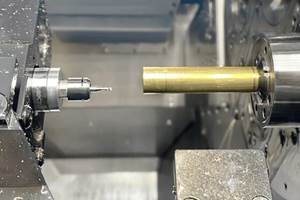Thread Milling On A Tiny Scale
Machining internal threads in difficult materials is challenging, especially when hole diameters are small. Thread milling offers advantages for these applications that are important to consider.
Share








Thread Milling Tiny Threads
Tapping is the preeminent technique shops use to machine internal threads in a variety of materials. That said, thread milling is a viable alternative especially when hole diameters are small and workpiece materials are exotic.
Mark Hemmerling says that although thread milling isn’t new to the machining scene, its use is not widespread. However, the marketing manager for Walter USA points out that thread milling is particularly effective in creating small, internal threads in difficult materials such as titanium and stainless steel because it overcomes the prime challenge in small-scale threading: chip control.
Tapping operations in the materials mentioned above tend to generate stringy chips that can cling to the tap, Mr. Hemmerling explains. This can create a bird’s nest around the tap that can lead to oversized threads or cause the tap to bind and break inside the part. Conversely, thread mills that move in an upward, helical tool path inside a hole generate short, controllable chips that are readily evacuated out of blind or through holes using coolant or an air blast.
The Walter Prototyp division manufactures solid carbide thread mills that can create threads as small as M1.6 with a 3:1 length-to-diameter ratio. The thread milling guidance Mr. Hemmerling offers here is helpful to shops that are looking for a different way to thread tiny holes.
Milling’s Advantages
Thread milling offers the same advantages for threading small holes as it does for standard-sized holes. A single thread milling tool is able to produce both blind and through holes; right- and left-hand threads; and multiple thread sizes that share a common pitch. Thread mills are also able to machine complete threads very close to the bottom of a blind hole because the bottoms of these tools are flat.
In addition to that machining versatility, tool breakage does not necessarily result in workpiece rejection. When taps snap in very hard metals, it might be possible to use EDM hole drilling or some other method to remove the broken tap and salvage the workpiece. In some instances, though, the part is scrapped.
Let’s Go To The Video
A helpful video shows a thread mill creating M2-sized threads in materials ranging from cast iron to titanium. (See the box to the right for the link to that video.) A few aspects of thread milling are clarified in the video, such as the way the small cutter enters the material. The tool moves in an initial downward cutting motion toward the bottom of the hole to begin the cut. This gradual “ramping” into the material allows the tool to achieve full radial engagement and eliminate taper that deflection would cause upon entering the material. After the downward motion, the tool is moved in thread milling’s signature helical tool path up and out of the hole. (Most modern CNC machine tools are capable of performing such helical interpolation.)
The video also shows a side-by-side comparison of tapping and thread milling. You’ll notice that when the tap exits the hole, the machine’s spindle continues to spin the tap as it dwells above the threaded hole. This is part of the rigid tapping cycle that synchronizes the spindle RPM with the feed rate. What’s also evident is the difference in spindle actuation between threading operations. Tapping requires that the spindle start, stop, reverse, stop and start again. On the other hand, thread milling is performed using continuous, single-direction spindle rotation from hole to hole.
Some small thread mills are limited to a threading length-to-diameter ratio of 2:1. However, the TiCN-coated Walter Prototyp thread mills include design elements that reduce deflection and allow threading to depths of 3:1. For instance, a reduced neck and short cutting section of just three pitches minimizes deflection because radial pressure on the tool is reduced. The 15-degree helix strikes a balance between rigidity and chip evacuation, while an oversized shank offers strength and allows for multiple clamping lengths. This proves helpful when machining threads in recessed holes.
Thread milling speeds and feeds must be modified based upon material tensile strength, hardness and elongation characteristics. Walter USA offers an online application called Computer Cutting Data Service (www.cutting-data.com) that assists customers in thread mill selection, recommends speeds and feeds, and estimates tool life. It can also generate thread milling code for many common CNCs.
Related Content
A History of Precision: The Invention and Evolution of Swiss-Style Machining
In the late 1800s, a new technology — Swiss-type machines — emerged to serve Switzerland’s growing watchmaking industry. Today, Swiss-machined parts are ubiquitous, and there’s a good reason for that: No other machining technology can produce tiny, complex components more efficiently or at higher quality.
Read MoreWhere Micro-Laser Machining Is the Focus
A company that was once a consulting firm has become a successful micro-laser machine shop producing complex parts and features that most traditional CNC shops cannot machine.
Read More3 Tips to Accelerate Production on Swiss Lathes with Micro Tools
Low RPM lathes can cause tool breakage and prevent you from achieving proper SFM, but live tooling can provide an economical solution for these problems that can accelerate production.
Read MoreRead Next
Building Out a Foundation for Student Machinists
Autodesk and Haas have teamed up to produce an introductory course for students that covers the basics of CAD, CAM and CNC while providing them with a portfolio part.
Read MoreSetting Up the Building Blocks for a Digital Factory
Woodward Inc. spent over a year developing an API to connect machines to its digital factory. Caron Engineering’s MiConnect has cut most of this process while also granting the shop greater access to machine information.
Read More5 Rules of Thumb for Buying CNC Machine Tools
Use these tips to carefully plan your machine tool purchases and to avoid regretting your decision later.
Read More



























.png;maxWidth=150)






.jpg;maxWidth=300;quality=90)
















